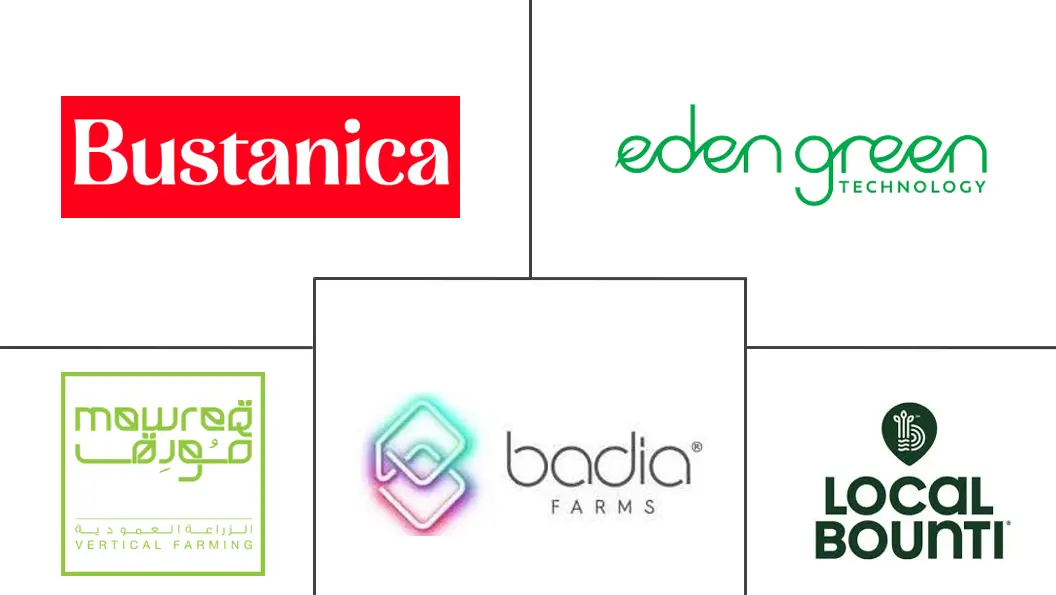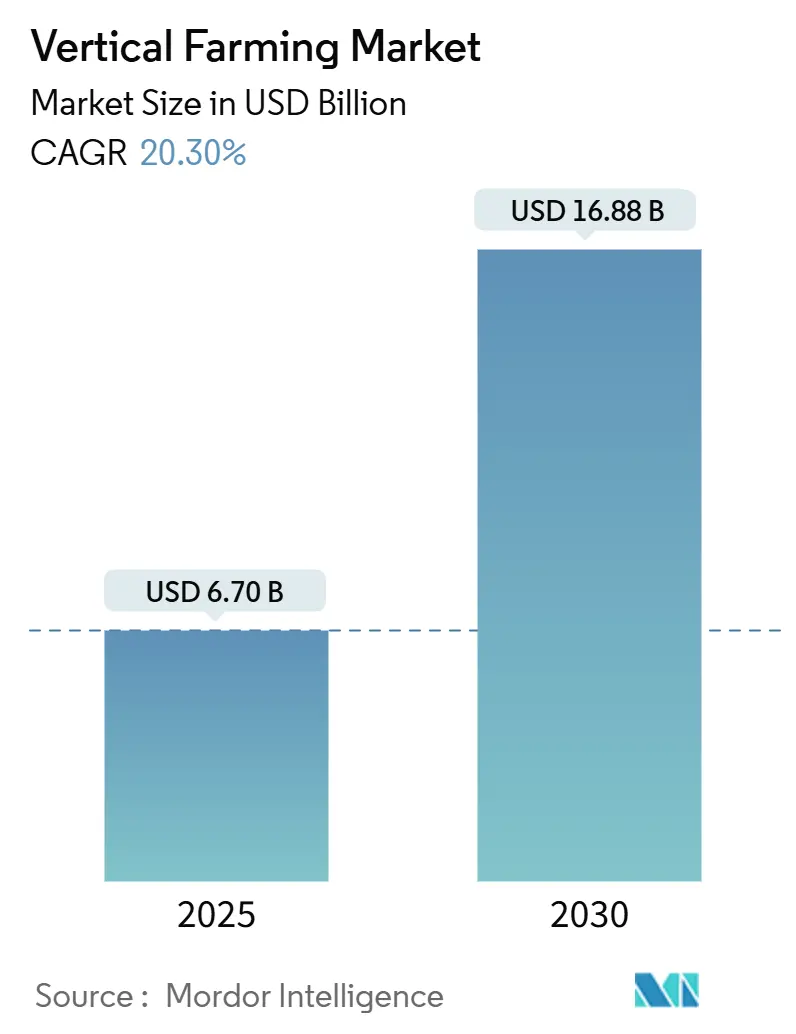
Vertical Farming Market Analysis by Mordor Intelligence
The Vertical Farming Market size is estimated at USD 6.70 billion in 2025 and is projected to reach USD 16.88 billion by 2030, at a CAGR of 20.30% during the forecast period. Robust expansion stems from tightening urban land availability, technological cost deflation, and rising institutional investment. North America retained leadership with a 39.1% revenue share in 2024, but the Middle East posts the fastest 15.5% CAGR through 2030 as food-security programs finance mega-facilities. Hydroponics held 57.1% of production value, while aeroponics outpaced at 24.1% CAGR due to superior yield-per-foot economics. Lighting accounted for the largest 38.5% capital outlay, yet climate-control systems show the quickest 20.2% growth as operators sharpen energy efficiency. Competition remains fragmented, with top-five vendors controlling over 20% of 2024 revenue, leaving ample room for specialized entrants and regional champions.
Key Report Takeaways
- By growth mechanism, hydroponics led with 57.1% of vertical farming market share in 2024, and aeroponics is projected to expand at a 24.1% CAGR to 2030.
- By structure, building-based farms captured 61.3% revenue share in 2024, while shipping-container systems are forecast to rise at a 23.5% CAGR through 2030.
- By components, lighting represented 38.5% of the 2024 value share, whereas climate-control solutions are set to grow at a 20.2% CAGR by 2030.
- By crop, lettuce and leafy greens commanded 46.2% of the vertical farming market size in 2024, and berries are projected to accelerate at a 27.3% CAGR over 2025-2030.
- By geography, North America accounted for 39.1% of revenue in 2024, yet the Middle East logs the highest 15.5% CAGR to 2030.
Global Vertical Farming Market Trends and Insights
Drivers Impact Analysis
| Driver | (~) % Impact on CAGR Forecast | Geographic Relevance | Impact Timeline |
|---|---|---|---|
| Urbanization-driven demand for local fresh produce | +2.5% | Global, early gains in North America, Europe, and Asia-Pacific | Medium term (2-4 years) |
| LED, automation, and AI cost-down curve | +1.8% | Global | Short term (≤ 2 years) |
| Climate-resilient food systems amid extreme weather | +1.2% | Middle East, North Africa, global | Long term (≥ 4 years) |
| Government incentives and ag-tech investments | +0.8% | North America, Europe, and Middle East | Medium term (2-4 years) |
| Carbon-credit revenue stacking for VF operators | +0.6% | Europe and North America | Long term (≥ 4 years) |
| Corporate ESG on-site micro-farm installations | +0.4% | North America and Europe | Medium term (2-4 years) |
| Source: Mordor Intelligence | |||
Urbanization-Driven Demand For Local Fresh Produce
Global urban residency is on track to reach 70% by 2050, intensifying pressure on metropolitan food logistics. Operators such as Eden Green deliver lettuce from harvest to shelf within 48 hours, cutting transport routes from thousands of miles to within city limits while using 99% less land and 98% less water.[1]Eden Green Technology, “Hyper-local Production Model,” edengreen.com Singapore’s “30 by 30” strategy illustrates national-level adoption, and solar-powered indoor farms are scaling to supply one-third of the city-state’s nutritional needs by 2030.
LED, Automation, and AI Cost-Down Curve
Lighting now represents the single largest controllable expense. Cornell University trials lowered lettuce energy demand from 9.5 kilowatt-hours per kilogram to 6.42 kilowatt-hours per kilogram. Cornell University trials used spectrum-tuned LEDs and AI scheduling. Siemens and 80 Acres Farms further display how digital twins and robotics standardize workflows across global footprints.
Climate-Resilient Food Systems Amid Extreme Weather
Heatwaves and droughts erode open-field reliability, steering capital toward fully enclosed farms. The United Arab Emirates has invested USD 100 million in indoor research and now hosts ECO-1, a 330,000-square-foot unit producing more than 2 million lb of greens annually.[2]Crop One Holdings, “ECO-1 Facility Factsheet,” cropone.com Technical University Munich studies show vertical farms achieve higher protein yield density than field legumes while shielding output from weather shocks.
Government Incentives and Ag-Tech Investments
Government incentives and rising ag-tech investments have become critical catalysts for the vertical farming market, fueling its global expansion. Public programs lower entry barriers. The United States Department of Agriculture earmarked USD 14.4 million for urban agriculture grants in 2025, with awards up to USD 250,000 targeting vertical farming technology. The United Kingdom’s EUR 5 million (USD 5.8 million) sustainable-farming call and Maine’s first C-PACE-backed USD 59.5 million Vertical Harvest facility highlight blended finance models.
Restraints Impact Analysis
| Restraint | (~) % Impact on CAGR Forecast | Geographic Relevance | Impact Timeline |
|---|---|---|---|
| High energy intensity and capex | −1.5% | Global | Short term (≤ 2 years) |
| Narrow crop-portfolio profitability window | −0.8% | Global | Medium term (2-4 years) |
| Skill gap and operational complexity | −0.6% | Global; acute in developing regions | Long term (≥ 4 years) |
| Unclear GMO micro-green regulatory pathway | −0.3% | North America, Europe | Medium term (2-4 years) |
| Source: Mordor Intelligence | |||
High Energy Intensity and Capex
Electricity absorbs 50–65% of operating budgets, trials record 12.5 kilowatt-hours per kilogram of lettuce, pressuring margins where grid tariffs exceed USD 0.12 per kilowatt-hour. Light-emitting diodes now average 3.2 micromoles per joule, up from 2.5 micromoles per joule in 2023, and artificial intelligence–orchestrated heating, ventilation, and air conditioning trims another 25% load. Yet, container retrofits, while cheaper upfront at USD 15,000-20,000, struggle with poorer thermal mass and, thus, higher per-unit energy cost.
Skill Gap and Operational Complexity
The Commonwealth Scientific and Industrial Research Organisation (CSIRO) flags an aging plant-breeder workforce as graduates decline, jeopardizing genotype optimization for enclosed environments. Agritecture notes that several venture-backed entrants collapsed because engineers underestimated crop-science nuance. In response, universities are launching CEA certificate courses, and vendors bundle agronomy services with hardware sales to shorten learning curves.
Segment Analysis
By Growth Mechanism: Commercial Strength of Hydroponics, Innovation Edge of Aeroponics
Hydroponics commanded 57.1% of the vertical farming market in 2024. Proven nutrient recipes, scalable hardware supply, and straightforward system maintenance keep it the first choice for large retailers. Aeroponics, growing at 24.1% CAGR, atomizes water into a fine mist, accelerating biomass by up to 30% and saving 95% water. The vertical farming market size for aeroponics is forecast to climb briskly alongside rising berry and vine-crop adoption. Despite lower current penetration, aquaponics creates symbiotic fish-and-vegetable revenue streams that hedge price volatility.
Commercial evaluations weigh capital intensity against throughput. Hydroponic rails cost USD 80-100 per square meter, while aeroponic towers exceed USD 140 but return faster cycles. Data-driven fertigation is narrowing this gap, and some operators hybridize both methods within the same facility. Insurance underwriters increasingly favor aeroponic redundancy because misting nozzles isolates root disease outbreaks, reducing recall exposure.
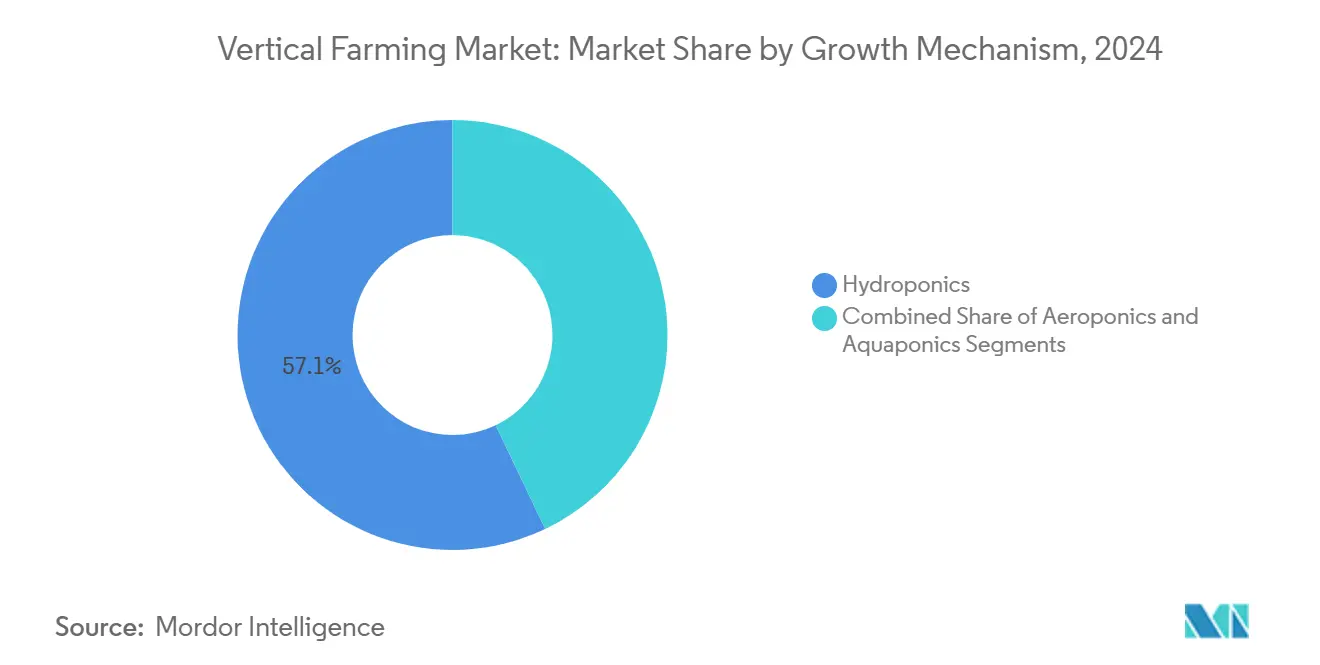
Note: Segment shares of all individual segments available upon report purchase
By Structure: Scalability in Buildings, Portability in Containers
Buildings held 61.3% of 2024 revenue, reflecting supermarket-scale volumes and the ability to integrate rooftop solar or co-located waste-heat recovery. Container farms, though only a fraction, rose at 23.5% CAGR as universities, hospitals, and corporate campuses purchased turnkey modules. Freight Farms noted a 32% uptick in orders from nonprofits during 2024.
Economics diverges over asset life. Buildings amortize over 20-25 years and qualify for green-bond financing, containers depreciate in seven years and endure higher per-pound utility costs. Nevertheless, disaster-relief agencies value container mobility, dispatching units within 30 days after extreme weather knocks out supply chains.
By Components: Lighting Leads Spend, Climate Systems Sprint Ahead
Lighting captured 38.5% of the 2024 value share. Vendors now offer dynamic PPFD that modulates photon flux in real time with wholesale power prices. Paired with demand-response contracts, farms in deregulated United States markets save up to USD 0.04/kWh. Climate systems post the top 20.2% CAGR, driven by integrated CO₂ enrichment, dehumidification, and sensor arrays costing under USD 300.
Nutrient-delivery kits and inert media also evolve. Automated dosing stations analyze EC and pH every two minutes, slashing manual labor by 40%. Biodegradable cellulose mats replace rock wool in leafy-green germination, easing waste-stream compliance and bolstering corporate ESG metrics.
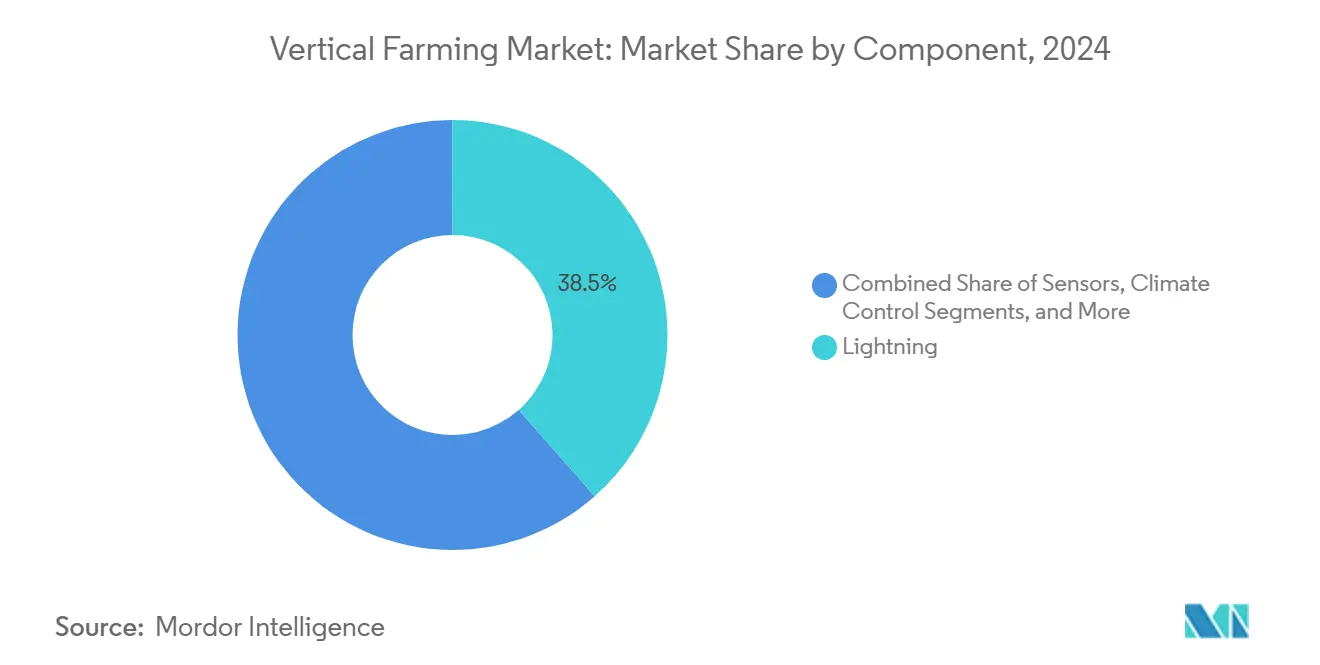
Note: Segment shares of all individual segments available upon report purchase
By Crop: Leafy-Green Foundation Enables Premium Berry Diversification
Leafy greens accounted for 46.2% of revenue in 2024, benefiting from 30-45-day cycles and stable retail demand. Container systems clock yields 11 times higher per acre equivalent, with margins lifted by pesticide-free positioning. Berries, while niche, are the fastest climbers at 27.3% CAGR. Oishii’s 237,000-square-foot strawberry hub sells at USD 2.50 per berry, validating premium pricing for flavor consistency.[3]Produce Blue Book, “Oishii Opens World’s Largest Strawberry Farm,” producebluebook.com
Tomatoes and peppers occupy mid-tier economics: research cites yields of 626 kg of tomatoes and 1,050 kg of cucumbers per square meter annually in optimized farms. Microgreens offer two-week cycles catering to food-service channels. Operators engineer a variety of rotations to maximize rack utilization across seasons.
Geography Analysis
North America remained the largest regional contributor, delivering 39.1% of 2024 revenue. The United States Department of Agriculture (USDA) grants, retailer partnerships, and consumer willingness to pay a 20-30% premium for local greens underpin momentum. United States facilities, such as a USD 56 million, 30,000-square-meter complex in Georgia, illustrate how brownfield warehouses convert into year-round suppliers. Canada’s GoodLeaf leverages hydroelectric tariffs to maintain a competitive cost of goods.
The Middle East is the vertical farming market’s fastest region, expanding at 15.5% CAGR. Sovereign funds finance large enclosures to bolster food security amid arid climates. ECO-1 in Dubai, the world’s largest vertical farm, now produces more than 2 million lb of leafy greens each year, and the UAE plans 500 additional sites by 2030. Systems here are frequently coupled with desalination plants, using waste heat and brine mineral streams to enhance resource efficiency.
Asia-Pacific shows mixed signals. Singapore accelerates solar-integrated towers to meet its “30 by 30” target, whereas several ventures in Malaysia shut down due to high electricity tariffs. China’s state-backed institutes focus on multi-story greenhouse hybrids rather than full indoor builds. Europe faces zoning hurdles and high construction costs, yet Dutch greenhouse operators attract private equity funding.
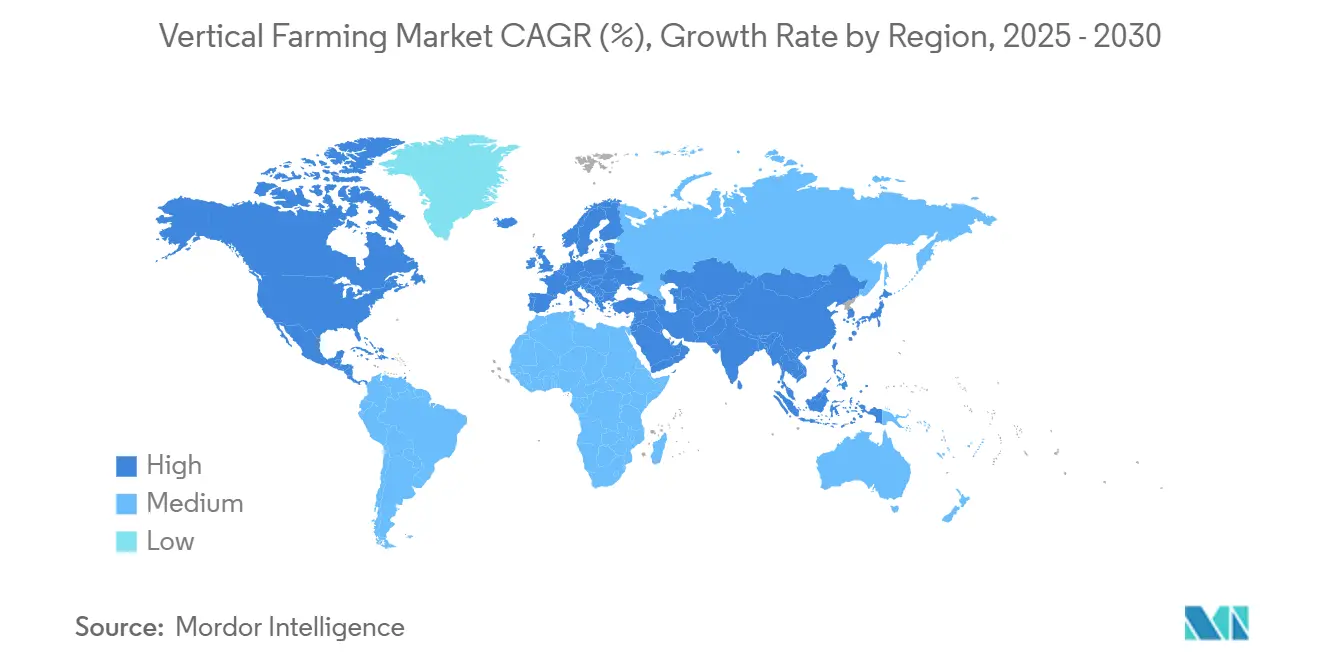
Competitive Landscape
Industry concentration is fragmented, with the top five players together holding over 20% of the 2024 turnover. Strategic landscapes diverge between technology-heavy startups and ag-practitioner-led companies. Cox Enterprises pivoted into produce supply by acquiring BrightFarms, illustrating the conglomerate's appetite for controlled environment assets. Local Bounti’s purchase of Pete’s similarly reflects roll-up logic to secure retail shelf space.
Operational discipline separates winners from over-capitalized failures. Bowery Farming’s plant closures underscore that aggressive scale without agronomic rigor magnifies execution risk. By contrast, Vertical Harvest secured USD 59.5 million via USDA loan guarantees after demonstrating positive unit economics in an earlier Wyoming micro-farm. Partnerships with automation specialists like Siemens signal convergence between industrial engineering and horticulture know-how.
White-space opportunities persist: regional berries, medicinal botanicals, and service-bundled hardware for institutional buyers. Suppliers that package software, agronomy consulting, and carbon-credit facilitation positions for sticky recurring revenue. Mid-tier growers pursue certification (e.g., Global G.A.P.) to lock in premium channels and hedge against commodity price swings in leafy staples.
Vertical Farming Industry Leaders
-
Emirates Bustanica
-
Badia Farms
-
Local Bounti Corporation
-
Mowreq Specialized Agriculture Company
-
Eden Green Technology
- *Disclaimer: Major Players sorted in no particular order
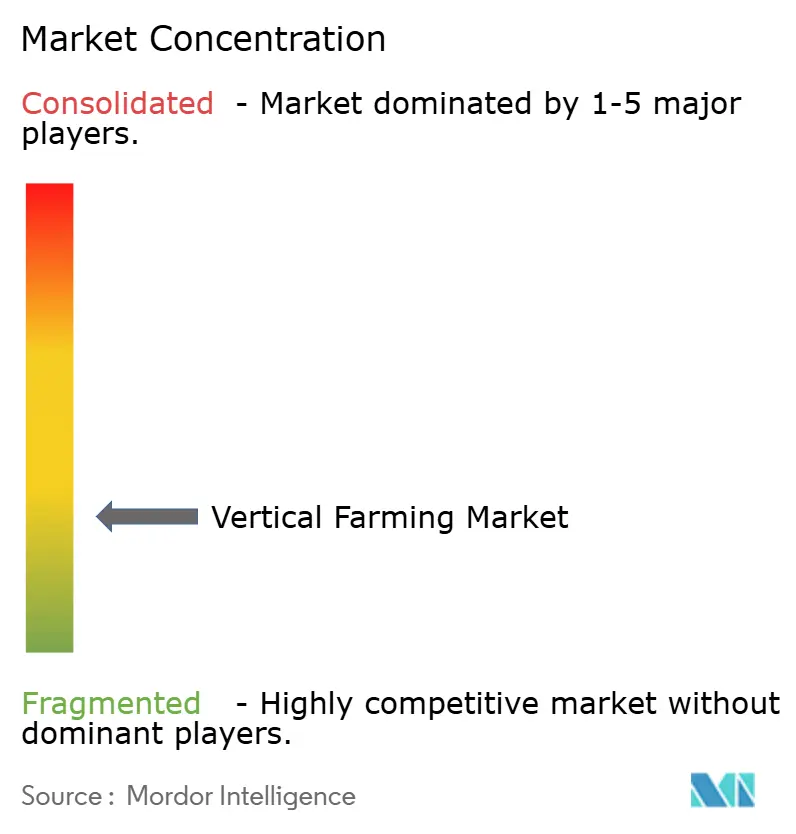
Recent Industry Developments
- February 2025: Mowreq Specialized Agriculture and YesHealth Group have established Saudi Arabia's largest indoor vertical farm in Riyadh. The facility stands 15 meters tall and covers 20,000 square meters across 19 layers. The farm utilizes artificial intelligence for monitoring, automation, and water recycling systems to produce 2,200 kilograms of leafy greens daily.
- November 2024: Eden Green Technology's Herb Program, recognized as one of TIME's Best Inventions of 2024, optimizes vertical greenhouse herb production through microclimate control. The program supplies ten herb varieties to retailers like Walmart and Sysco, with delivery within 48 hours of harvest.
- October 2024: Food Tech Valley established a 27-year partnership with Spinneys to construct a 500,000 sq. ft. food processing facility in Dubai. This development aligns with Dubai's strategy to enhance food security through local production and agricultural technology advancement.
Research Methodology Framework and Report Scope
Market Definitions and Key Coverage
Our study defines the vertical farming market as all revenue generated from crops grown in vertically stacked layers inside controlled-environment facilities that rely on soil-less techniques such as hydroponics, aeroponics, and aquaponics, together with the associated lighting, climate, nutrient, and sensing systems that enable year-round production.
Scope exclusions: outdoor greenhouses, rooftop poly-houses, and traditional soil-based indoor farms are not considered.
Segmentation Overview
- By Growth Mechanism
- Hydroponics
- Aeroponics
- Aquaponics
- By Structure
- Building-based Vertical Farms
- Shipping-Container-based Vertical Farms
- By Components
- Lighting
- Climate Control
- Sensors
- Other Hydroponic Components (Nutrient Dosing Systems, Inert Grow Media, etc.)
- By Crop
- Tomato
- Berries
- Lettuce and Leafy Greens
- Pepper
- Cucumber
- Microgreens
- Other Crops (Spinach, Culinary Herbs, etc.)
- By Geography
- North America
- United States
- Canada
- Mexico
- Rest of North America
- Europe
- United Kingdom
- France
- Sweden
- Rest of Europe
- Asia-Pacific
- Singapore
- China
- Japan
- Taiwan
- Rest of Asia-Pacific
- Middle East
- United Arab Emirates
- Saudi Arabia
- Israel
- Rest of Middle East
- Africa
- South Africa
- Kenya
- Rest of Africa
- North America
Detailed Research Methodology and Data Validation
Primary Research
We interviewed farm operators in North America, Europe, and Asia, LED and HVAC component suppliers, energy advisors, and retail produce buyers. Their insights refined crop yield assumptions, average selling prices, and energy-mix sensitivities, allowing us to adjust model coefficients and close data gaps flagged during secondary review.
Desk Research
Mordor analysts first mapped the global installed base of building-based and container farms through open trade registries, agriculture ministries, and customs codes 8446/8479. They then blended volume signals from sources such as FAO's AQUASTAT, USDA urban agriculture briefs, Eurostat agri-tech datasets, and patent families captured in Questel that trace LED spectra and nutrient dosing innovations. Company filings, SPAC decks, and VC term sheets complemented the picture, while news feeds screened via Dow Jones Factiva flagged capacity expansions and shutdowns. This desk work grounds the starting universe; however, many more public and subscription sources were reviewed for validation and context.
Market-Sizing & Forecasting
A top-down capacity-to-revenue model converts known farm footprints into potential output using crop-specific yield factors, then applies realized capacity utilization and average selling price bands validated through interviews. Select bottom-up checks, sampled supplier roll-ups and channel ASP × volume, are layered in to reconcile totals. Key variables driving the forecast include LED price trajectories, commercial electricity tariffs, urban real-estate costs, retail premiums for pesticide-free produce, and venture capital inflows that fund new builds. Multivariate regression combined with scenario analysis projects these drivers through 2030, while short-term ARIMA smoothing addresses seasonality in leafy-green demand. Any bottom-up coverage shortfall is bridged by adjusting utilization rates within historically observed limits.
Data Validation & Update Cycle
Outputs undergo multi-step triangulation, variance testing, and peer review before sign-off. The model is refreshed annually, and interim updates are triggered when material events, large farm closures, subsidy shifts, and major tech breakthroughs alter baseline inputs. A final analyst pass just before publication ensures clients receive the latest vetted view.
Why Mordor's Vertical Farming Baseline Is Dependable
Published estimates vary because each firm chooses its own scope, input mix, and refresh rhythm.
Differences in whether hardware revenue is bundled, how container farms are counted, and the speed at which LED cost curves are embedded often widen the gap.
Benchmark comparison
| Market Size | Anonymized source | Primary gap driver |
|---|---|---|
| USD 6.70 B (2025) | Mordor Intelligence | |
| USD 9.66 B (2025) | Global Consultancy A | Bundles grow-light hardware sold to cannabis growers and applies aggressive 90% capacity utilization assumption |
| USD 8.52 B (2025) | Trade Journal B | Uses constant 15% ASP inflation and omits container-farm attrition rates |
| USD 5.60 B (2024) | Regional Consultancy A | Excludes aquaponic output and has a one-year older currency base |
These comparisons show that when scope creep, untested utilization levels, or outdated baselines are stripped away, Mordor's disciplined variable selection and annual refresh deliver a balanced, transparent starting point that decision-makers can trust.
Key Questions Answered in the Report
What is the current size of the vertical farming market?
The vertical farming market was valued at USD 6.70 billion in 2025 and is projected to grow to USD 16.88 billion by 2030.
Which region leads the vertical farming market growth?
North America leads in revenue with 39.1% share, while the Middle East is the fastest-growing region at a 15.5% CAGR.
What segment holds the largest vertical farming market share?
Hydroponics tops the list, contributing 57.1% of revenue in 2024.
What is the main restraint slowing vertical farming adoption?
High energy intensity and upfront capital costs reduce profitability in markets with expensive electricity.
Page last updated on:
